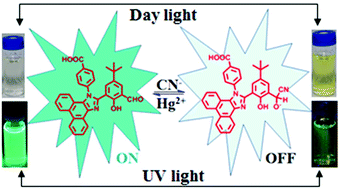当前位置:
X-MOL 学术
›
Photochem. Photobiol. Sci.
›
论文详情
Our official English website, www.x-mol.net, welcomes your
feedback! (Note: you will need to create a separate account there.)
Fluorescent imidazole-based chemosensors for the reversible detection of cyanide and mercury ions†
Photochemical & Photobiological Sciences ( IF 2.7 ) Pub Date : 2018-09-22 00:00:00 , DOI: 10.1039/c8pp00226f Ganapathi Emandi 1, 2, 3, 4, 5 , Keith J. Flanagan 1, 2, 3, 4, 5 , Mathias O. Senge 1, 2, 3, 4, 5
Photochemical & Photobiological Sciences ( IF 2.7 ) Pub Date : 2018-09-22 00:00:00 , DOI: 10.1039/c8pp00226f Ganapathi Emandi 1, 2, 3, 4, 5 , Keith J. Flanagan 1, 2, 3, 4, 5 , Mathias O. Senge 1, 2, 3, 4, 5
Affiliation

|
We report 4-(2-(5-(tert-butyl)-3-formyl-2-hydroxyphenyl)-1H-phenanthro[9,10-d]imidazol-1-yl)benzoic acid 1 and 4-(2-(5-(tert-butyl)-3-formyl-2-hydroxyphenyl)-4,5-diphenyl-1H-imidazol-1-yl)benzoic acid 2 as reversible luminescent sensors for the detection of cyanide and mercury ions. These imidazole derivatives were characterized using spectroscopic techniques and single crystal X-ray crystallography. The compounds showed sensing exclusively towards CN− ions, which resulted in the quenching of fluorescence and a decreased singlet state life time. The detection limit of imidazole derivatives 1 and 2 were found to be 0.8 μM and 1.2 μM respectively, in a CH3CN/H2O system. Job's plot analysis, 1H NMR spectra and LC-MS studies supported the formation of the respective cyanohydrin. This cyanohydrin was further used as a reversible sensor for the detection of Hg2+ ions through metal-assisted elimination. The reversibility and reusability of sensors for the detection of CN− and Hg2+ ions were tested for four consecutive cycles.
中文翻译:

基于荧光咪唑的化学传感器,用于可逆检测氰化物和汞离子†
我们报告4-(2-(5-(叔丁基)-3-甲酰基-2-羟苯基)-1 H-菲[9,10 - d ]咪唑-1-基)苯甲酸1和4-(2 -(5-(叔丁基)-3-甲酰基-2-羟基苯基)-4,5-二苯基-1 H-咪唑-1-基)苯甲酸2作为可逆发光传感器,用于检测氰化物和汞离子。使用光谱技术和单晶X射线晶体学对这些咪唑衍生物进行表征。化合物表现出只朝向CN传感-离子,这导致荧光的猝灭和降低的单重态寿命。咪唑衍生物1和在CH 3 CN / H 2 O系统中,发现2个分别为0.8μM和1.2μM 。Job's图分析,1 H NMR光谱和LC-MS研究支持了各自氰醇的形成。该氰醇还进一步用作可逆传感器,用于通过金属辅助消除来检测Hg 2+离子。可逆性和用于检测CN的传感器的可重用性-和Hg 2+离子连续四个周期进行了测试。
更新日期:2018-09-22
中文翻译:

基于荧光咪唑的化学传感器,用于可逆检测氰化物和汞离子†
我们报告4-(2-(5-(叔丁基)-3-甲酰基-2-羟苯基)-1 H-菲[9,10 - d ]咪唑-1-基)苯甲酸1和4-(2 -(5-(叔丁基)-3-甲酰基-2-羟基苯基)-4,5-二苯基-1 H-咪唑-1-基)苯甲酸2作为可逆发光传感器,用于检测氰化物和汞离子。使用光谱技术和单晶X射线晶体学对这些咪唑衍生物进行表征。化合物表现出只朝向CN传感-离子,这导致荧光的猝灭和降低的单重态寿命。咪唑衍生物1和在CH 3 CN / H 2 O系统中,发现2个分别为0.8μM和1.2μM 。Job's图分析,1 H NMR光谱和LC-MS研究支持了各自氰醇的形成。该氰醇还进一步用作可逆传感器,用于通过金属辅助消除来检测Hg 2+离子。可逆性和用于检测CN的传感器的可重用性-和Hg 2+离子连续四个周期进行了测试。











































 京公网安备 11010802027423号
京公网安备 11010802027423号